
|
||
|
Portland art blog + news + exhibition reviews + galleries + contemporary northwest art
|
||
Jeff Koons at MCA Chicago 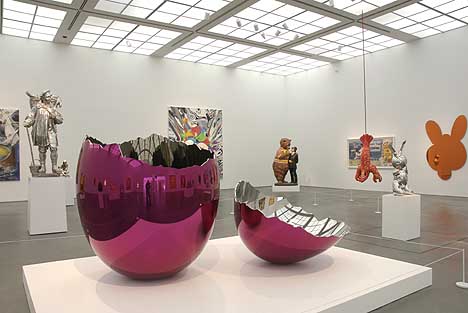 Installation view of Jeff Koons at the Museum of Contemporary Art, Chicago, May 31 - September 21, 2008. Photos © Museum of Contemporary Art, Chicago. Photos by Nathan Keay. How much a person in the art world loves and or hates Jeff Koons mostly depends on how much they appreciate how thoroughly he manages the viewer's experience and expectations. For some it is too patronizingly complete and for others it's an open-ended parody of how patronizing a lot of art is. For the more casual viewer he's one of the few contemporary artists who can be practically guaranteed a response, which is rare and deserves serious attention. To put it mildly, he is a master of the conflicted pop response (like Warhol before him and Hirst after) and it is those other two artists that help bracket and benchmark our understanding of him. Warhol was endlessly fascinated by celebrity (aka the nexus of attention) whereas Koons is fascinated by the act of art as a form of faith in his own celebrity as a showman. In fact, Koons and his art reminds me of Space Ghost Coast to coast on Cartoon Network... all puffed up, somehow invincible, totally in control in his own mind, yet ridiculous... the host with the most, but you gotta wonder, "The most of what? Optimistic self-confidence?" It's not like Koons can get cancelled by a network, he just gets another gallery or museum. 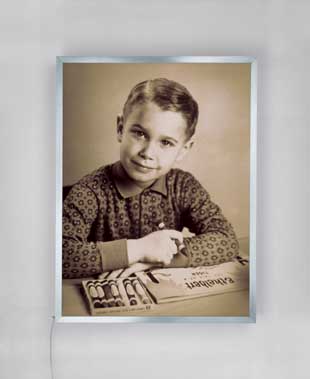 Jeff Koons, The New Jeff Koons, 1980. Private Collection. © Jeff Koons In the case of a pieces like his busts or The New Jeff Koons (some of his most personally revealing yet weakest works) one senses the issue here... he knows himself so well that all truth is obscured. He's all show business but man does he put on a show. For example his balloon dog is the ultimate party favor, making every viewer feel like it's their birthday. Who cares if it isn't your birthday and who wouldn't want something so silly and fun? Koons art is definitely way funnier than Warhol, who was bittersweet and poetic by comparison. Still, Koons just isn't devastating like Warhol can be, instead he's thoroughly entertaining. Compared to Hirst, who is obsessed with death as the ultimate celebrity, Koons seems like a traditionally calculated art world player... working tidily away in the New York system during the 80's then going global in the 90's as New York got sick of his enviable success (he also weathered the art market crash like few others). Maybe Hirst wants to reinvent the game (by avoiding museums & manipulating his own markets) but maybe it is because Koons mastered the obvious way before him? The truth in all this comparative ethical/aesthetic wrangling is how thoroughly these three pop philosophers have exploited visual exploitation and Koons seems like the most corporate of the three. In fact, walking around this show felt just like watching Tim Burton's remake of Charlie and the Chocolate Factory... slick entertaining and purposefully pointless in an expensive way. I love the Gene Wilder version and I bet Koons does too, but Koons can only make the slicker "Burton style" product. Which is not to say it's not a worthwhile, in fact Koon's retrospective at Chicago's MCA is pretty good. The show is laid out in a novel way, with two large square open galleries and an atrium hallway between them. (the MCA Chicago has some of the best designed galleries in the country... I love the barrel vaulted spaces upstairs as well) 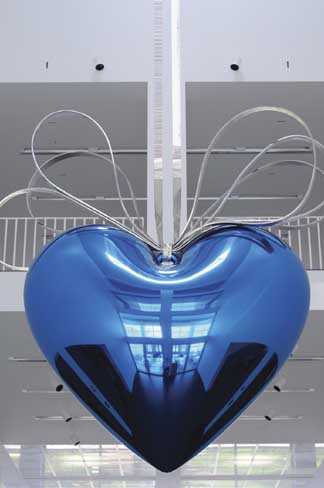 Jeff Koons, Hanging Heart (Blue/Silver), 1994-2006. Collection of William J. Bell. Photo by Arnold GmhB. © Jeff Koons. In the atrium space one first encounters the giant "Hanging Heart (blue/silver)," it is probably a glib plea, "please love me," but in a cold manufactured way. Or maybe it's the cold blue reflection of the viewers in the heart themselves; maybe that cold blue reflection is the manufactured love that Koons brings? Either way it is the size of a wrecking ball! I started with the gallery on the right, which proved to be the better of the two. It began with the earliest piece in the show "The New Jeff Koons (1980)." The likeness of Koons beams out of the light box telling us everything we need to know, every work fill feel exactly like the grin on young Koons' face. He seems to say, "my inner child is invincible... do you really want to deny a precocious 8 year old?" Ok I understand this guy, I would have avoided him in elementary school like the plague, but I admire him as an insidious, twisted adult. The basketballs in vitrines float in a permanent state of useless and fetished grace; the vacuum cleaners are interesting too, like stuffed cobras in a vitrine. No housework today for us, this is art! The statuary busts of himself and his wife give the gallery a baroque air but they are dull without all of the better pieces like the small stainless steel Bob Hope tchotchke… I grew up watching Bob Hope too and I see some of his deadpan timing in Koons. The giant broken egg in the middle of the room reflects and fragments ones view of the space, a completely obvious metaphor for the museum experience of forming and shattering one's pre conceived notions. It works and I like how it pulls the whole room together like a super massive black hole of kitsch at the center of a galaxy. 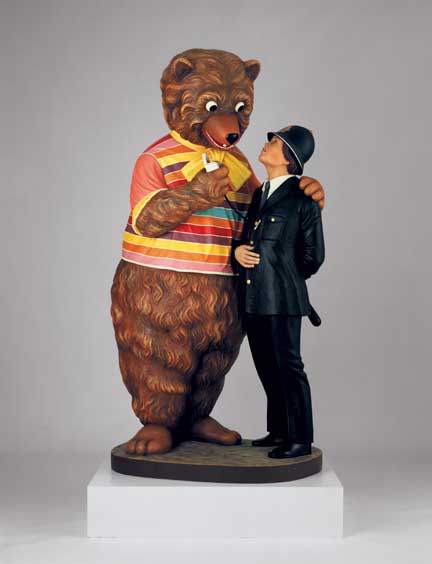 Jeff Koons, Bear and Policeman, 1988. Collection of Jeffrey Deitch. © Jeff Koons My favorite work is "Bear and Policeman" from 1988. Made by master craftsmen it is Koon's masterpiece... a cloying and oddly sexual Hummel figurine from hell. The policeman should be blowing the whistle for kitsch abuse but the whistle never comes and Koons is getting away with this. This is the art the 1980's deserved most. No matter what your situation was, steroid using baseball player, coke addled model, sincere Sunday school teacher or someone in the Midwest rocking out to Def Leppard....this thing is what that era deserved. An unblinking, dead eyed cipher of kitsch wrapped in pleasantness and authority gone very wrong. Another piece from the same series "Ushering in banality" with several kids pushing a pig is less poetic but you get the idea. 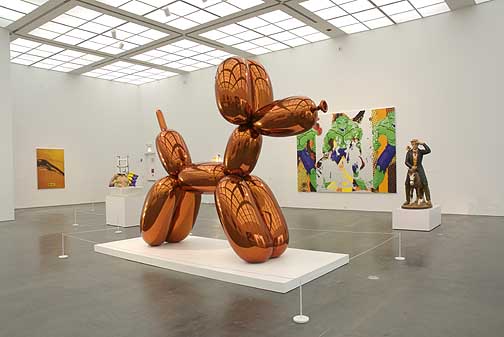 Installation view of Jeff Koons at the Museum of Contemporary Art, Chicago, May 31 - September 21, 2008. Photos © Museum of Contemporary Art, Chicago. Photos by Nathan Keay. The next room has the previously mentioned Balloon Dog as well as the oddly sexual "Pink Panther" sculpture. It also has a lot of paintings... which go from tolerable but 3rd tier pop art mashups like Hulk Elvis to his dull made in heaven pornographic efforts. The point is the second room was mostly redundant and less revealing and in general that goes for Koons in many ways. He's good but he's not Warhol. He might not even be Damien Hirst but I suspect of the three, only Koons will be the only one to die happy. Overall, I was left with the feeling that postmodern art at some point became a tchotchke or merit badges for corporate globalism and the manufactured feel of all this is definitely interesting, but a little dated. At some point the Postmodernists Warhol, Koons and Hirst (the last of the POMO's?) decided that the best artist was the most expensive artist. Conceptually it is interesting but the fact wealth did not improve the quality of thought or work from these three horsemen of the aPoPalypse. Warhol's Elvis and Marylins, Hirst's Shark and Koons' Bear and Policeman are their legacies and each peaked a long long time ago. Had they been of Michelangelo's caliber they each would have outdone themselves when the serious backing came along. Instead they became consistently good, an accomplishment to be sure, but not the highest of them. It's worth catching this show at Chicago's Museum of Contemporary Art Jeff Koons ends this weekend September 21st Posted by Jeff Jahn on September 19, 2008 at 18:16 | Comments (6) Comments Every photograph I have seen of this show makes the space look horribly cluttered. However, when every single one of Koons' pieces are desperately screaming for attention, it is easy for a space to feel exhausting to look at. Despite some of the work being nearly 30 years old, his work still feels amazingly fresh. Maybe not "cutting edge" anymore, which is somewhat ironic since I consider him and Hirst responsible for defining where the "edge" is in contemporary art. "the last of the POMO's?" I don't know, that's a tough statement. For some reason I feel like we will forever be Postmodernists from this point on, and only the fads will change. Posted by: Calvin Ross Carl Space Ghost Coast to Coast is on the Cartoon Network, not Comedy Central Posted by: eggson Do you even re-read your posts before hitting submit? "Overall, I was left with the feeling that postmodern art at some point because a tchotchkes or merit badges for corporate globalism and the manufactured feel of all this is definitely interesting, but a little dated" Posted by: eggson Fixed... I only have cable when Im in hotel rooms and actually MS word often does ore damage than good. This is still an unedited publication so thanks for the eyes. and just to quibble, postmodernism is just a reactionary part of modernism, it isn't separate. The big change was the industrial revolution. We are just in a slightly different era of the modern experiment.... more of a true pluralism than we had during the 70's and 80's (somewhat less involved in french theory)? When he and I spoke even Rancier thought that it is different now. Posted by: Double J I'm pretty sure the way you're using the word reactionary has nothing to do with what that word actually means. Posted by: Liam Drain I understand that we are currently in a political season but not every word with political overtones has to be read by that one interpretation. via webster: reactionary: relating to, marked by, or favoring reaction. I mean exactly that... postmodernism was a reaction heavy movement... especially to the way Alfred Barr and Greenberg had laid a very defined course for "modern art". Personally, I preferred the way they were talking about art in the late 60's early 70's of "pluralism." When it came to be described as postmodern the discourse became very reactionary... reacting to AbEx angst, reacting to the gallery sysytem, reacting to and forwarding their own social agendas as defined mostly by french theory. It was a very reactionary... because it tended to favor reaction (of course this doesnt describe everything). That's fine Today things are a little more loosely defined and more truly pluralistic again. Artists can react without being reactionary. It's a question of measured response and we are more used to the international responsiblities of being a good (or bad) global citizen. Im glad your sensitive to this but I promise to use the words conservative and liberal as well... with no political meaning in the near future. Posted by: Double J Post a comment Thanks for signing in, . Now you can comment. (sign out)
(If you haven't left a comment here before, you may need to be approved by
the site owner before your comment will appear. Until then, it won't appear
on the entry. Thanks for waiting.)
|
| s p o n s o r s |
 |
 |
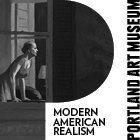 |
 |
 |
 |
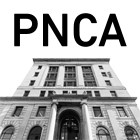 |
 |
 |
 |
 |
 |
 |
 |
 |
 |

|
Site Design: Jennifer Armbrust | • | Site Development: Philippe Blanc & Katherine Bovee | |


![[TypeKey Profile Page]](http://www.portlandart.net/nav-commenters.gif)